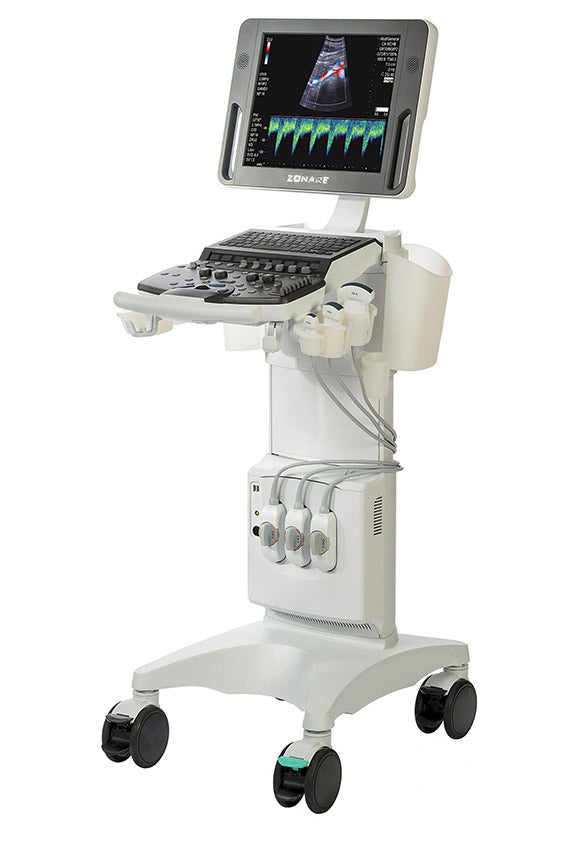Zonare ultrasounds are highly specialized and coveted systems. Although these systems aren’t a “jack of all trades” so to speak, they are one of the premier systems for vascular, MSK, and other similar applications.
In the late 2000’s, Mindray purchased Zonare’s ultrasound division, but kept the brand name, recognizing the esteemed reputation that the name Zonare carries.
One of the benefits of using Zonare equipment for vascular and similar studies, is that most of the transducers feature a wideband lens, allowing the end-user to cover more ground in the ultrasound image. The longer the rubber lens on the probe head, the more is captured in the ultrasound.
Popular Vascular Probes:
Before discussing any specific Zonare probe, what makes these probes continuously popular is the fact that these probes (mostly) are all compatible with all generations of Zonare systems. From the original Z One, to the Z One Pro, to the ZS3 systems, which are still being manufactured as of this publishing, one could keep the same transducer for twenty years and use it with the different systems!

L8-3: The Zonare L8-3 ultrasound probe, aside from being enormously popular for vascular studies; peripheral vascular, small parts (breast, thyroid, fingers, feet), and larger patients that require a lower frequency emission to see veins, muscles, and nerve blocks.
L10-5: The L10-5 probe is similar to the L8-3, but has a slightly higher frequency and frequency range. The biggest difference is that the probe can be used to needle-guided injections, pain management, and other operations.
L14-5w: This probe is particularly popular for a few reasons: Firstly, is has a very high frequency range. Fourteen MHz is higher than most standard transducers, and allows for extremely superficial imaging. The “w” stands for “wide-band” and the lens is much wider than most other probes on the market.
L20-5: The L20-5 linear probe is a highly specialized and rare probe. It is almost exclusively used for superficial vascular, MSK, injections, and other forms of high-frequency ultrasound imaging. Very few manufacturers make transducers that have a frequency range that high, making it highly desirable.
L14-5sp: This probe, although having the same frequency range as the wide-band probe, is a hockey-stick probe. This is the opposite of the wide-band in terms of design, and has a tiny sliver of a lens. The benefit, however, is the ability to capture an ultrasound image of hard to reach spots; fingers, palms, noses, crevices in the shoulder or hip, and other locations that’re ordinarily difficult to access.
Other Capabilities:
The Z One Pro is also popular for cardiac imaging, and is even compatible with a TEE (transesophageal) cardiac probe. It has a few different cardiac probes for a variety of patients; adults, children and teenagers - and the frequency range of the probe will indicate which patient to use the probe on. For example, a 1-4 MHz probe will penetrate deeply enough to capture an adult’s heart, or a relatively large teenager. A 5-8 MHz probe, on the other hand, is best used for children and physically smaller adults and teens.
The Z One Pro has a similar versatility with abdominal transducers; there’s about four or five varieties of cured array probes, some with a MHz frequency range up to 10 Mhz.: Something very rare in the ultrasound world.
While there are a few vaginal probes that are compatible with the system, most sonographers or doctors will opt to get an alternative ultrasound for OB-GYN imaging, from brands that develop better software and imaging technologies for women’s health studies.
There is always the concern, particularly when it comes to medical equipment, regarding the safety of the devices and the potential side effects that occur as a result of employing these machines.
It is important to know that ultrasound machines are known to be completely harmless. They function through the utilization of sound waves emitting from the probe or transducer. These sound waves are then translated into images by the ultrasound machine or system. There is no need to fear when using ultrasound machines – it is a quick, easy and efficient way to diagnose and help determine a patient’s ails.
At A.M.E. Ultrasounds we pride ourselves on providing top quality customer service. If you have a particular topic you’d be interested in learning more about or reading about, feel free to contact us!
If you’d like to learn about the author, click HERE
If you’d like to contact us, click HERE
Sincerely,
Your team at A.M.E. Ultrasounds
Ephraim@ameultrasounds.com
